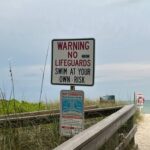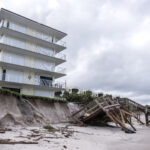INDIAN RIVER COUNTY — Faced with a dilemma of whether to fast-track renourishment of beaches this fall or to embark on permitting a relatively untested process of using sand from Sebastian-area mines to boost the economy, members of the Beaches and Shores Preservation Advisory Committee sent a clear signal to the County — just get the job done.
Barrier Island residents have lived in fear of further beach erosion since the hurricanes of 2004 as the Sector 3 beach renourishment project has been in the design and regulatory process for about two years. About 30 members of the public, mostly beachside residents, attended Wednesday’s meeting, waiting to hear the fate of their beaches.
This is not the county’s first time around in terms of beach renourishment. An area from the Sebastian Inlet south to Ambersand Beach was shored up in 2007. The county also took on the severely eroded Sector 7 area, which includes Castaway Cove. Those projects were completed by pumping in sand from the ocean floor just offshore, the way communities all over Florida have been renourishing beaches since the 1960s.
Earlier this year, local sand mine operators petitioned the Board of County Commissioners to open up the bidding process to them for the sake of jobs and supporting local businesses with taxpayer dollars. Commissioners agreed and staff adjusted the bidding requirements to allow for an upland provider of trucked-in sand to be able to qualify.
Jonathan Gorham, director of the county’s Coastal Engineering division of public works, said the process was definitely not the standard.
“To our knowledge, this bid process has been unique,” Gorham said.
After some confusion over whether the committee was to recommend a specific bidder or just to make a recommendation in general to the County Commission, Commissioner Peter O’Bryan gave the group some guidance.
“In my point of view, what would be most helpful to me is to give us your priority of whether it’s most important to get it done this year or the economics is the most important issue,” he said.
Some of the sand mine operators who had submitted bids were present and wanted to debate the merits of their proposals and the way the staff had ranked and analyzed them. They will be given a chance to meet with staff individually but their concerns were not entertained in the forum of the meeting.
“In a general sense, I’m very uncomfortable discussing your bid or someone else’s bid, I’m very uncomfortable discussing the nuances,” Walther said.
Mike Ochsner, Town of Indian River Shores appointee, made the motion to recommend to the Board of County Commissioners that the first priority would be completion of the Sector 3 project in the 2009-2010 fiscal year ending September 2010.
The motion was seconded by Vice Mayor Tom White of the City of Vero Beach. The motion passed with Simchick and citizen appointee Robert Lindsey dissenting.
The Board of County Commissioners will make the final choice of a bidder on Sept. 8 at its regularly scheduled meeting.
Twenty-five bid packets were purchased and seven proposals were submitted, three from off-shore sources and four from upland contractors. After receiving additional scientific data from the bidders, county staff ranked the sources of sand according to grain size, quality and consistency.
“The different sand sources proposed by the various providers would not perform equally,” Gorham said.
Stormwater and Underground LLC, which would get its sand from the Davis Sand Mine, was found to be the apparent low bidder based on the ranking criteria. The price proposed by this bidder is $8,548,746 with an overfill factor of 1.00, which would indicate that it is nearly a perfect fit.
“I think that the upland provider, because he’s got good documentation and good quality sand, I think it is feasible that we might obtain permits within 60-90 days,” Walther said. “If we can show that the contractor can provide a consistent quality of sand it’s feasible that we can obtain permits within 60-90 days, I don’t think it’s going to be that complicated, if we can get the upland sand provider to work with the staff.”
Bill Glynn, a beachside resident who chairs the committee, fought right up to the vote to take a chance on the local contractor.
“What I’m looking at right now, what we have to consider is the economics, we have to look at keeping as much of that money as we can in Indian River County,” Glynn said.
The challenge with this bidder is that an extensive beach renourishment project the scope of Sector 3 has not been permitted, implemented and studied over time by the Florida Department of Environmental Protection and the U.S. Army Corps of Engineers, who must sign off on the design.
“Price is not the only factor, permitting is also a major factor. If we choose to elect an upland sand source contractor, these permits are going to need to be modified,” Gorham said. “Modifying these permits will take some additional time and will impact the project schedule, particularly in regard to the the time constraints we’re operating under.”
Construction can only take place from November 1 through May 1 as to not disturb sea turtle nesting. Gorham estimated that construction could begin by Thanksgiving with an off-shore source of sand, but that upland sand might delay the start date to the spring of 2010, requiring the county to stop and re-mobilize in the fall of 2010, possibly leaving beaches partly exposed during the 2010 hurricane season.
Engineer Michael Walther, principal of consultant Coastal Tech, explained that beach renourishment projects involve an “overfill factor” which equates to the amount of sand that needs to be placed on the beach to perform the same way as natural beach sand.
The two bidders with competitive prices and low overfill factors were Stormwater and Underground LLC and Great Lakes Dredging, which is the company the county used for the Sectors 1, 2 and 7 projects. Great Lakes is an out-of-state company, where Stormwater and Underground is headquartered in Sebastian.
The county may opt to construct project using its own funds and has 3 years to submit for reimbursement under state cost share, plus the Sebastian Inlet Taxing District is contributing $4.68 million toward local share. So, Gorham said, if the state cost sharing is approved, a project costing up to $9.36 million would be built with no net cost to the county.
Glynn said anyone intersted in the issue should show up. The meeting begins at 9 a.m. in Building A of the County Administration Complex.
“If any of you all folks do want to come, it is going to be public and Chairman Davis will usually open it up,” said Commissioner Peter O’Bryan, the commission liaison to the beaches and shores committee.






